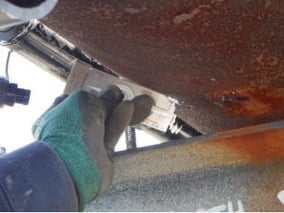Introduction
Touch point corrosion (TPC) is a damage mechanism that plagues industry. Highly localized areas of corrosion, such as those at the contact points between pipes and their support structures, often experience accelerated external wall loss presenting compounded integrity concerns as the damage is difficult to avoid, detect, measure, and remediate.
These TPC challenges on piping systems, otherwise known as corrosion under pipe supports (CUPS) and contact point corrosion (CPC), are some of the most common causes of piping external corrosion damage (Figure 1). This is often due to the difficulty the supports present in enabling the pipe to be properly maintained at its contact points. These contact points also create areas for dissimilar metal and oxygen concentration cell corrosion. Visual inspection is often difficult and, until recently, it was also challenging to inspect these areas with nondestructive testing (NDT) methods.
Advanced on-stream nondestructive inspection technologies do exist, such as electromagnetic acoustic transducer (EMAT) technology, that can inspect for TPC. However, while these methods allow operators to identify areas of concern, line lifting is still required to access the pipe contact point to further assess any identified damage and mitigate the problem.

Historical Issues Associated with Traditional Line Lifting Techniques
The historical problem associated with line lifting is the inherent risk of loss of containment and associated production, health, safety, and environmental hazards while lifting a line still in service. In the past, this associated risk often led to reactive repairs surrounding any TPC issues versus planned maintenance. Damage was only addressed once it was an emergency, which required the costly task of performing work outside of a turnaround by taking the system offline.
Today, there are several lifting methods that exist, but only a few provide a truly safe and efficient option to effectively manage TPC remediation.
Cranes
Cranes are often used to lift larger lines or lines on the top of a pipe rack. The problem is that cranes have limited ability to accurately adjust lift height, and there are no hard stops preventing pipes from being lifted too high and being over-stressed. Observers must confirm initial separation and lift heights, which places workers close to the hazard. Because crane lifts are classified as suspended loads, as opposed to temporarily supported structures, they are not typically considered safe to work beneath unless the load is physically secured by blocking. Additionally, cranes can only expose one touch point at a time. Inspecting a lengthy run of pipe utilizing a crane can be time consuming and costly. They also require a large operating footprint at the worksite and are less able to lift pipes below the top level of a multi-level piping rack.
Chain Blocks
A chain block (or chain fall) is used to lift and lower heavy loads using a chain and pully system. The blocks must be rigged to a load-bearing structure above the pipe to be lifted or to a temporarily installed support structure. Like a crane, the load being lifted by the chain block is considered a suspended load and typically only one touch point can be exposed at a time. Operators that are operating the chains alongside the touch point being lifted are placed in a potential “line of fire” hazard. They also do not have any type of associated regulating mechanism to ensure proper lifting height is not exceeded.
Rudimentary Line Lifting Jacks
Rudimentary line lifting jacks exist to eliminate the need for a crane, crane operator, or rigger. They can be used in almost any environment. They attach beneath the supporting beam with mechanical screws or hydraulic rams to elevate the lines. These tools can be effective, but the operator may need to be very close to the lift point, and the jacks typically only expose one contact point at a time. These jacks may also require clearance below the supporting beam to attach to the structure. As such, they may not be useful for ground-level supports.
All the lifting methods mentioned above are viable options for line lifting, but all have their own set of risks.
Most conventional tools and methods used to lift lines lack sophisticated safety features and the ability to expose multiple touch points at once.
The most significant risk of all associated with any of these historically conventional lifting methods is not the methods themselves, but the lack of detailed analysis and planning to ensure the pipe stress and deflection is managed throughout the lift. Proceeding to lift a line without this data puts operators at risk by uncertainties associated with the potential of placing unacceptable stress on what may be a compromised pipe.

















Comments and Discussion
Add a Comment
Please log in or register to participate in comments and discussions.